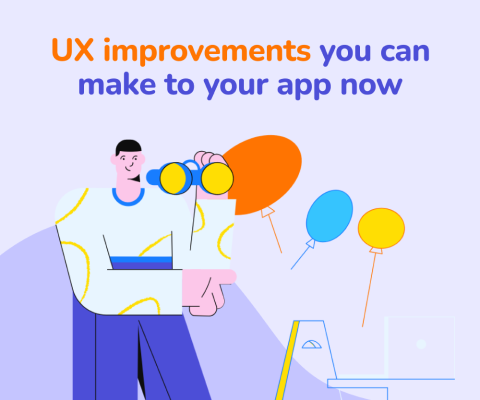December 17th, 2025, posted in for_founders
by Adelina
A visually pleasant and easy to use software product makes for happy customers. Especially in a rapidly evolving market, where a lot of people can do what you do, better than you and with lower prices. It’s essential to stand out, and a great way to achieve that is through UX design.
UX design handles how an app feels. It takes a list of goals and turns them into positive experiences for their target audience. It ensures that users can find their way through complex apps, that they don’t make major mistakes and that they’ll want to return to your app.
By investing time and resources into UX design, you’ll get a better shot at offering a great user experience to your customers, which will, in turn, increase conversions. It might seem unnecessary, or an overkill, but in the long run it’s going to show results.
So in this article, we’re going to talk about what UX design means from a business perspective, how it can improve your products and make for satisfied customers. And why you should invest in it.
What is UX design?
Let’s start with the basics. Aside from what you can tell by the meaning of its acronym, “user experience”, UX design is actually very complex. It not only comprises actions and flows within an app, but the study of an app’s users - what they want, what they need, and how you can help them achieve their goals.
As a term, UX design goes along with its visual counterpart, UI. You’ll often hear about UI/UX design, which refers to both the look and feel of apps. Half of it represents the visual side of apps, such as colors, layouts, styles, icons, and so on.
While the other half represents the way those visual elements create an entire experience for potential users. Such as, using colors and shadows to highlight active sidebar menu items. Or using contextual help (tooltips, text boxes, tutorials, and so on) to guide users through complex processes in the app. Or red buttons to signify a serious action that can have negative consequences, such as deleting something.
Through UX design, you’re creating a journey through an app, at the end of which users should be able to fulfill a goal. Good UX will successfully guide users through several options and settings, and will make it easy to use a complex app. It’ll also keep them from making mistakes and notifying them of what’s new, in progress, or not working well.
UI and UX design usually go together, which means the same one person would be in charge of both. Paying more attention to UX means looking more into who the app users are and what they need. UI, on the other hand, is the creative element of it all, where the designer lets their imagination take the wheel. But with UX, they’ll use research and proper facts in order to craft a proper user experience.
What is user-centered design?
If you’re in need of UX design, you’re most likely building a software product. That software either sells things or services, and your customers are either regular people or entire businesses. This means that you’re building a product for people. You’re actually, rather, building it for profit. But customer satisfaction breeds income - you can’t make money out of a product that doesn’t serve its intended audience.
In the UI/UX design world (or just the product development world in general), you’ll hear the term “user-centered design” quite often. This concept refers to designing products in such a way that they best serve their intended users. Which, in turn, means getting to know those users.
And so, the first big step in user-centered design is getting to know your users. And that doesn’t mean just knowing how old they are, what they do for a living and how much money they make. User research isn’t meant for surface-level information only, but also, most importantly, it’s meant to help you get in the minds of your users.
You’ll need to find out what the users’ main goals are (which can be fulfilled through the app you’re building), what their problems regarding those goals are, what solutions they’ve tried, what they wish they could do and can’t do at the moment (regarding those goals). Surface-level info is also important, as long as it’s blended in with these facts. For instance, you’ll need to know if your potential users work busy jobs and need quick and easy solutions. Or if they’re non-technical and they need tutorials when using complex software.
Having all of this info about your potential users will help you craft a better experience, suited for them. You’ll know what their main problem is, the context of said problem and what their end goal is. All there’s left to do is to find a solution for that problem, while taking into account what you know about the users’ lifestyle.
That is user-centered design. You’re building software products where the main goal is to create a product best suited for its intended users. By creating a good user experience, you’re ensuring that users will want to keep using your product and will return if needed, as it fulfills their needs.
Why is UX design so important for businesses?
Just like physical products, creating software that best serves its audience will bring customer satisfaction. Which, in turn, raises conversion rates. And UX design plays a big role in how well an app’s user flows serve their intended audience.
UX design done well means having a series of user flows that guide users to their goals, while respecting their needs and solving the problems they came to an app for. A UX designer will interview users and find out what they need, which, in turn, will help them figure out how to design an app that best serves those needs.
This means that it’s more likely for you to have an end product that customers will enjoy using, which they’ll leave positive reviews to or tell their friends and family about. This not only increases your conversions, but also your customer rate and overall satisfaction.
By not investing in UX design, you risk releasing products that users won’t be happy with. Bad UX design means confusing flows, unclear information, hidden options that are too hard to find, and overall a user experience that makes people not want to use your app.
Bad UX design can also lead to bad reviews, low conversion rates, or customers switching to your competition who might have better UX. In other words, it’s not a good business practice to not invest in UX design.
You can’t make customers happy just by giving them an app that solves their problems. If the app that’s supposed to make their life easier rather does the opposite, then what did you even achieve? You’ll end up releasing a sub-par app that doesn’t actually serve its intended users.
What’s the best way to put good UX into practice?
Here at UPDIVISION we go by a strategy known as design-driven development. In this type of workflow, we start off new projects with an extensive product discovery process. This means that we take the time to listen to the business owners and their key customers, and then use the information we gather to design the entire app, which will then go into development.
Design-driven development allows for a more productive app building process. By getting to know the app’s industry, the client’s business model, who their users are and what they need, you get the chance to build more useful products, and you don’t go into development blindly.
This means holding preliminary meetings with the business owners and app stakeholders to properly understand what they’re trying to build and why. To truly get the best information out of them, it’s crucial to focus on the why. After these meetings, the next step is doing the same thing with the app’s intended users: holding user research and interviews to understand what they need and how the app could improve their workflows.
After understanding the why and brainstorming to figure out the how, UI/UX designers will get to mapping out the entire app. Fully-fledged, high-fidelity screens that accurately represent what the app will look like. This way, app stakeholders get to see the app before months of code. Not only is this cost-efficient, but it makes it easier to reiterate, add or remove features.
Through design-driven development, you’re more likely to release apps that provide a good experience for their intended audience. Especially when paired up with QA and manual testing done well, which means ensuring the app isn’t released with major issues inside.
Overall, UX design done well has a very high value for your business. Creating a good experience for your customers ensures they’ll want to keep using your app and they’ll spread the word about it. Which, for you, means getting great brand awareness and a good return on investment
Looking to create great software products, the design-driven way? Contact us and let’s see what we can do together. Not there yet, but wondering if you're doing things right with your app's usability? We provide a free UI/UX assessment worth $3K dollars.

















